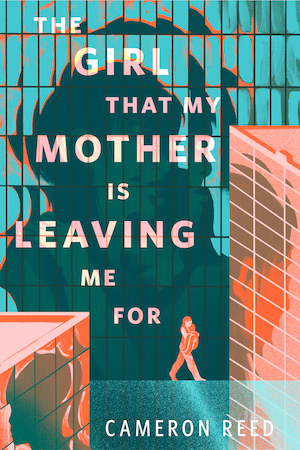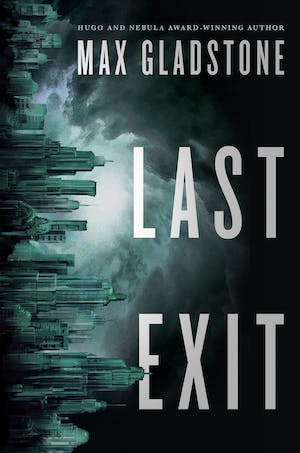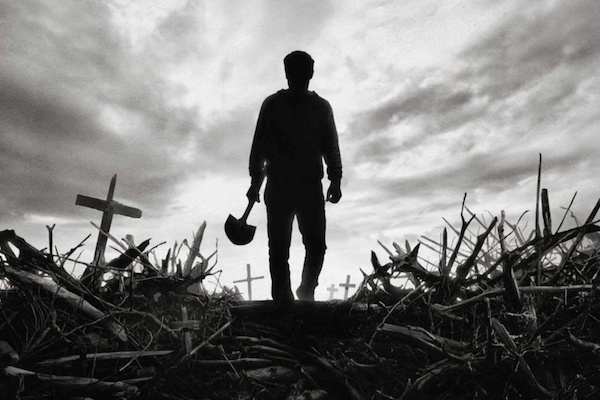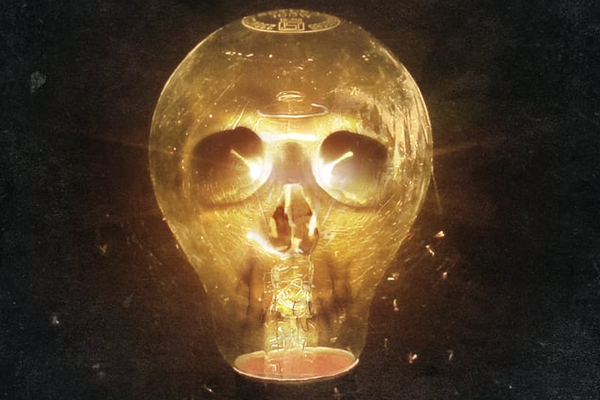Welcome back to Reading the Weird, in which we get girl cooties all over weird fiction, cosmic horror, and Lovecraftiana—from its historical roots through its most recent branches. This week, we continue Max Gladstone’s Last Exit with Chapters 23-24. The novel was first published in 2022. Spoilers ahead!
“Eye-sucking black beyond wriggled and writhed like the surface of boiling water, but when she tried to fix her gaze on what it was that moved, she saw only the dark.”
Zelda wakes up after her ordeal in the Medicine Wheel. Someone—Ramon—says her name, and yes, she’s Zelda still, ten years after losing Sal. Instead of lying beside the Wheel, she lies under a sod roof. Ramon watches her not with the scorn she expects, but with sad kindness. “I was wrong to send the letters,” she tells him. “You don’t owe me anything.” He answers: “We’re not here because we owe you.”
“We” includes June, who rushes in to hug Zelda, and Ish and Sarah. They’ve made it through the alts, robot horses towing the Challenger. Ish and Sarah echo Ramon: They have to fix this. But they reject Zelda’s suggestion that together, they can make the Wheel work. Staggering outside, Zelda sees why.
The cracks in the sky have plunged down into the alt-earth; widening cracks devour the stars and fracture the moon. Within is “a black hole in the shape of a woman taller than mountains.” The Wheel is gone, sucked into whatever lies beyond the cracks. Is everywhere like this, Zelda asks. Is home?
No way to know, because they can no longer get back. The best they can do now is go to the Green Glass City where “Brigit’s people” can help repair the Challenger. From there, they’ll continue to Elsinore. When June asks the same question that’s on the reader’s mind, Zelda remembers the princess dead, the queen falling “from rot-soaked battlements. “It’s the place where everything went wrong,” she says. “It’s where I lost her.”
Later that night, Zelda finds June out alone, “wrapped in shadows that wriggled like snakes.” June asks if Zelda’s afraid of her, but Zelda says June’s shadows are different. She describes finding the old Sal in the Wheel and they lean together, June’s shadows parting to allow it.
But the question Zelda senses in June’s tension goes unasked, its moment passing.
* * *
As the alt-riders inch east, Sarah thinks: This is “the road to the end.” Not that she believes in premonitions, but she always knew what Zelda’s summons meant: They left a task undone, and to protect the life she made afterwards, Sarah has to finish it. She wishes she’d told her children the truth of the world instead of keeping their memories as pain-free as possible.
Always one to plan ahead, she reviews her partners—and herself—like surgical tools before an operation. She’s good at traveling rough and protecting her friends. Ramon tinkers at the Challenger to figure out what will need repairing in the Green Glass City. Ish has the courage to fight on, not with ignorant optimism but with the conviction that they can do better in future quests despite “his own gimlet vision of just how fucked things really were.” But he’s lost his youthful softness: under the edgy steel he’s become, is that Ish still there?
As for Zelda, “haunted…unwhole”, is she still strong enough for the road?
Sarah checks in: Zelda knows the City will be bad, right? Zelda hopes not—they left it in a good place, well-supplied, mutants driven off. But, Sarah argues, look how life’s seeping out of the alts. Her tension exploding , Zelda shouts: What choice do they have? They’ll get through this, they have time.
Not much time, Sarah says. The cowboy’s still after them, closing fast. Sarah can hear him. When she leaves Zelda, she looks back and sees June hiding behind a rock, listening.
Sarah’s been hearing the cowboy’s booted footsteps since they left the Wheel. She’s thrown her spin against him with no lasting effect. June offers to help ward the cowboy off. Sarah’s been thinking of early days at college, when she felt adrift, an alien, with a roommate off in her own world. One night, drunk, she met Sal; on their way home, they clicked, two outsiders, soon closest friends. June might look like Sal, but she isn’t Sal. And maybe they should’ve kept Sal safer. Sarah turns down June’s help.
One day, riding with Ramon, June asks about Elsinore. He describes the Green Glass City instead, then relents. Elsinore’s a “postapocalyptic feudal” place, with castles and knights on motorback. Its princess knew her world was dying. She studied, and looked for the crossroads. After failing at the Wheel on her own, she enlisted the alt-riders’ help. Together they zeroed in on the crossroads, but the queen cursed them and called down the rot. The princess died. While escaping, Sal and Zelda saw the crossroads and tried to get there. Disaster.
June tells Ramon about Sarah’s struggles with the cowboy. Ramon agrees to talk to her, and try to get her to accept help. June also passes on Sarah’s worries about the Green Glass City. Ramon says they’ve been through a lot—it’s not too much, is it, to hope the City will be the one thing that breaks their way?
Fighting the Cowboy: Trees and cardiovascular research are not the most dramatic-sounding combination. And yet.
What’s Cyclopean: Sarah imagines the Cowboy as “a man waiting for a bird to roast, so caught by the visions the smell excites – crisp glistening skin, yielding meat, the juice inside—that when the call comes to dinner, he turns reluctantly from the bird in his mind to the bird on the table. But he comes to the table all the same.” Now, there’s an uncomfortable metaphor.
Libronomicon: Sarah thinks of Ish’s “softness” as a sword-wielding mouse from the Redwall series, and wonders if the heroic mouse still survives.
Weirdbuilding: The gang at Elsinore found spells and tricks, had their Wheel-walking apparatus all set up—they were just “waiting for the stars to be right.” Kinda makes you wonder… if you need to wait until the stars come right, what exactly do you think you’re summoning?
Ruthanna’s Commentary
When my godson was five or so, I took him to the Smithsonian Udvar-Hazy Center, where the Air and Space Museum keeps vehicles. He enjoyed running around looking at planes, and of course the highlight was the Discovery Space Shuttle. It’s not the only thing in that hanger: if you walk around near the tail, you’ll find yourself face-to-face with a collection of rockets including an ICBM missile. And your godson will ask, “What’s that one?”
I sympathize with Sarah, is what I’m saying.
It’s telling, however, that her carefully-constructed bubble of safety requires protection from knowledge as well as from actual danger. Because I did, in fact, have the age-appropriate nuclear war talk with my godson, as my parents did with me during the actual Cold War. I have talked to my kids about climate change, fascism, genocide, and several flavors of bigotry. I’ve also talked to them about protests, writing letters, mutual aid, and how to hide people in your attic when appropriate. Because if you don’t talk about the bad stuff, you can’t talk about how to fight back – and so Sarah has been not talking about how to fight back for ten years. People raised in an illusion would generally rather retreat back into lies than do the hard, dirty work required to gain for-real what they thought they already had – just ask the Cowboy.
Or don’t, because Sarah’s managing to keep him at a distance, for now. Which is good, and would be better if she weren’t insisting, Zelda-style, on doing it as a solo martyr. How do these people, who’ve been through so much together, come to be this resistant to working together? That’s a rhetorical question, but also—you can’t claim with one side of your mouth that the world is ending for everyone, and with the other that you’re keeping June safe by rejecting her contributions to saving the world. “Everyone” includes the gang. No exceptions for youth, inexperience, or nerve-wracking knacks.
At least we’re finally learning about Elsinore—which also turns out to be nerve-wracking. The Princess was a scientist, someone on the same mission as the gang and willing to team up to turn the Wheel. This raises the question again of the reality level of the alts. If they’re all nightmares from our world, you wouldn’t expect them to try and save themselves – and one of the consistencies of the gang’s old stories is that What These People Need is a Yalie. The Green Glass City is a prime example, all mind-control worms and mutants until the alt-riders appeared. Elsinore is different, not because it’s where “everything went wrong” but because it’s another locus of agency. The Princess not only wants to save the world, she’s an alt-rider in her own right.
Or was that an illusion? Did it “go wrong” because that was Elsinore’s particular nightmare? Subtler than mind-control worms it may be, but betrayal by those closest to you can feel pretty apocalyptic. What pushed the queen to undermine their work? What pulled the crossroads to them, only to tempt Sal into the rot? Did they name it for Hamlet’s tragedy-stage afterward, or did it come with that ill-omened name from the start? Maybe events played out with the force of nightmare narrative, or maybe it was mundane local politics – or maybe the same thing that’s trying to undermine their work now, one bullet at a time. More questions than we had about Elsinore before, and more interesting ones.
The major change this week, however, is the loss of access to their home dimension. Maybe Sal’s in the way, or maybe the Cowboy—either way, they can only go forward now. Can only have faith that there’s something to return to. It does feel of a piece with how the Princess de-centers the gang. Maybe our world isn’t the One True Reality that dreams the others into already-dying existence. Maybe it’s someone else’s nightmare, as fragile as any other illusion. Or maybe all the worlds are in this together, and there are more riders converging, each still convinced that survival depends on their solo heroism.
About that rhetorical question.
Anne’s Commentary
I was hoping after Chapter 24, what with the princess appearing in incandescent white glory, that Zelda’s flashback would continue into Chapter 25 and deliver the Elsinore backstory complete. Nope. Max Gladstone is like the flirtatious elf Snowball in David Sedaris’s Santaland Diaries. Max Gladstone leads readers on. Readers and Santas—I mean, readers and bloggers. Admittedly, Zelda discloses that the princess dies, and Ramon tells June that Elsinore is postapocalyptic feudal-core, down to the ladies’ cone-shaped hats. Ramon also pins the demise of both the princess and the alt-riders’ crossroads plans on Elsinore’s queen. A teaser here, a spoiler there, a great preview clip of the castle walls growing arms and mouths and eating people from the inside out. Elsinore: Where everything went wrong. Where Zelda lost Sal.
Moreover, we can’t go on to Elsinore in present story time until we’ve made a pit stop in the Green Glass City (GGC). Evidently, the GGC has a rad body shop where Ramon can repair the Challenger. It used to have mutants and may have them again if Sarah’s Cassandra-knack is right. Mutants are always worth a side trip. Besides, you’ve got to have a sentient muscle car if you want to cruise the cross-reality road in style.
The alt-riders have no option but to cruise on—their GO HOME game option seems to have expired. That’s if alt-riding ever was a game rather than an infectious compulsion to find the Eden-Alt, with Zelda as the index case.
Three-quarters of the way through Last Exit, I find my Character Sympathy Scale shifting. From the start, I disliked Zelda’s penchant for self-flagellation, but, girl, surely you’ve worn your cat o’ nine tails out! You were a brilliant if cosmically naive kid back in your college days. Fatally, you had the charisma to win other brilliant kids over to your crazy ideas, including Sal, who had the charisma squared to back you up. I can’t blame you for being seduced by the magic of spin. Given the dynamics of the alt-riders, the rest probably had to follow. The Yellow Brick Road goes forever on and on, and you must follow if you can.
That allowed, I wish you’d pull that whip out of your pack and chuck it into the perishing shrubbery. When you flail at yourself, you can hit the people around you, making them collateral damage to your guilt and, yes, to your self-pity. The first thing you do after waking from your post-Wheel stupor is to search Ramon’s face for the “scorn, pity, frustration” that you need to find there, confirmation your self-hatred is deserved rather than pathological.
It’s too late for Zelda to tell Ramon (yet again) she was wrong to send her letters, that he and the others owe her nothing. Ramon’s response demonstrates growing insight: “We’re not here because we owe you.” This isn’t the Zelda Show; what’s happening to the worlds is not all about her. Wheel-Sal has already told Zelda they’re in this together. “We’re with you all the way,” Ish says. Sarah adds “We have to fix this.”
The OG alt-riders haven’t come back to atone for deserting Zelda ten years before. Nor are they and June there as mere sidekicks. They can figure things out and make plans even when Zelda’s knocked out. They’ve come to save their own particular people and places. When Zelda slips back into telling Sarah that she shouldn’t have rejoined the quest because of her kids, Sarah’s answer is incontrovertible: “If the world ends, it ends for them too.” And who can argue that the end isn’t near, with sky and earth cracking in tandem and Beyond-Sal hovering ever visible?
Zelda’s drop on my Sympathy Scale may recover. She may hope things will end in her reunion with the unchanged Wheel-Sal; far more probable seems a confrontation with Beyond-Sal. Can she handle that and stay on mission? Zelda thinks she can, which is too weak an answer for Sarah, maybe rightly so in a cosmos where possibilities become realities through the magic of will or belief or faith, whatever powers spin.
June has been rising steadily on the Sympathy Scale and continues to do so in Chapters 25 and 26. Burdened by her new Rot-summoning knack, she can still ask Zelda whether this knack makes her Zelda’s enemy. She can empathize with Sarah, who’s expending a debilitating amount of energy to protect them from the cowboy. Sarah rises on the Scale through her strength and determination and the keen insight that can perceive Ish as all the more heroic because he may still be like a Redwall mouse: “goofy, brave, idealistic against all evidence.”
Her understanding of Ish pushes him higher on my Scale. Ramon has never slipped from an initial high rating.
Zelda can rise again. Much depends on whether she can toss that whip, or at least wield it against maybe-insurgent GGC mutants rather than herself.
Next week, Liz Williams’s “The Hide” seems like a nice cautionary tale against birdwatching. You can find it in The Weird.














While I think this is a wonderful book, I’ll admit some frustration in deciphering June. If we look at the original gang, each of their knacks does seem to be at least somewhat analogous to their personalities, to their personal trauma. The knacks are largely invisible as well. June is different. She certainly initially serves as a viewport for the reader, as the least experienced world-hopper, but at this point she’s kind of a passenger, and it’s difficult to see how her knack ties into her own self. Her inner world is less interrogated than the original group. Is she viewport or agent here? Probably both, that’s the most complex answer!
Oh interesting! To me it fits well with her openness to different means of changing the world. The others were all privileged Ivy League kids, told both that they could change everything with enough willpower and that they had a stake in the status quo. June comes in with a more gut-level rejection of things as they are.